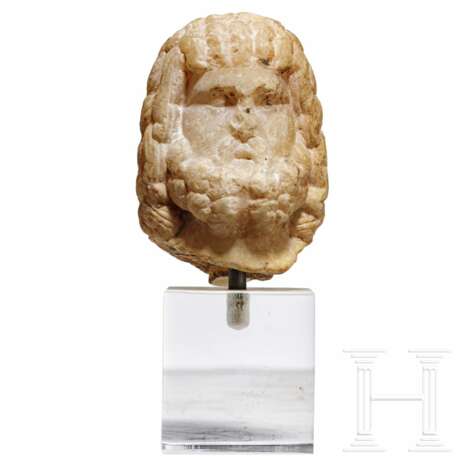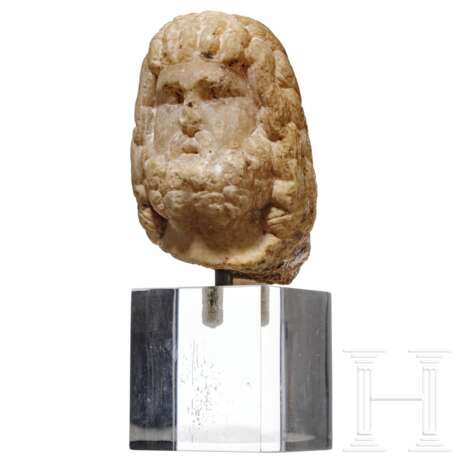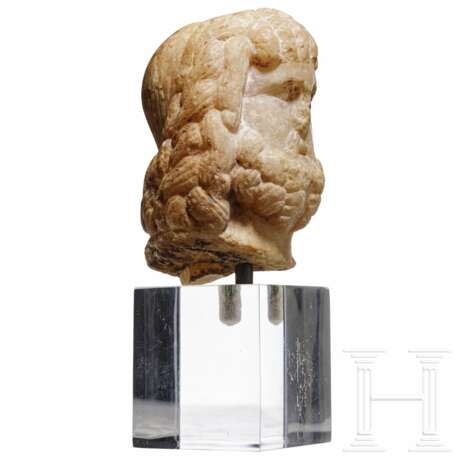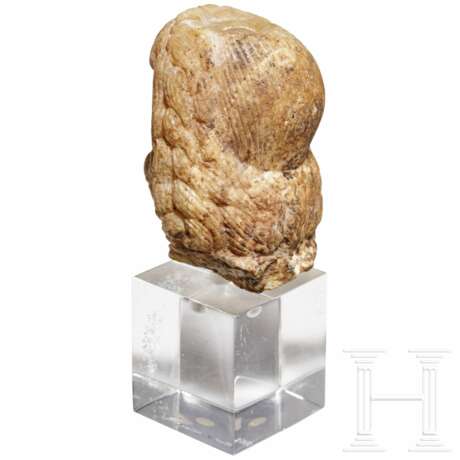ID 548691
Lot 533 | Kopf des Serapis, römisch, 2. - 3. Jahrhundert
Estimate value
€ 500
Fein gearbeiteter Alabaster. Der bärtige Gott blickt streng geradeaus, der schmale Mund ist leicht geöffnet. Das Gesicht ist gerahmt von voluminöser Frisur und Vollbart. Das Haar fällt in fünf breiten Strähnen auf die Stirn, seitlich fällt es in langen, zum Teil geflochtenen Strähnen herab. Auf dem Kopf befindet sich eine abgeflachte Fläche mit einer runden Aussparung für den ursprünglich separat gearbeiteten Modius. Die Nase bestoßen. Am Hals gebrochen. Schöne Patina. Auf Sockel montiert. Höhe 9 cm (mit Sockel 15 cm).
Als synkretistischer Kult mit ägyptischen und griechischen Zügen, der in Alexandria entstand, erfreute sich Serapis großer Verbreitung im hellenistischen und römischen Mittelmeerraum, wo er mit Zeus und Asklepios gleichgesetzt wurde (zu diesem Aspekt B .A. Martens, "Sarapis as healer in Roman Athens. Reconsidering the identity of Agora S 1068", in: Autopsy in Athens. Recent archaeological research on Athens and Attica, Oxford 2015, S. 51 - 65).
Provenienz: Schwedische Privatsammlung. Erworben auf dem deutschen Kunstmarkt.
Zustand: II -
A Roman head of Serapis, 2nd - 3rd century
Finely worked alabaster. The bearded god looks straight ahead, the narrow mouth slightly opened. The face is framed by a voluminous hairstyle and full beard. The hair falls in five broad strands on the forehead, at the sides it falls down in long, partly braided strands. On the head is a flattened area with a round recess for the modius, which was originally worked separately. The nose is bumped. Broken at the neck. Beautiful patina. Mounted on a base. Height 9 cm (with base 15 cm).
As a syncretic cult with Egyptian and Greek features that originated in Alexandria, Serapis enjoyed widespread popularity in the Hellenistic and Roman Mediterranean, where he was equated with Zeus and Asclepius (on this aspect B. A. Martens, "Sarapis as healer in Roman Athens. Reconsidering the identity of Agora S 1068", in: Autopsy in Athens. Recent archaeological research on Athens and Attica, Oxford 2015, pp. 51 - 65).
Provenance: Swedish private collection. Acquired on the German art market.
Condition: II -
| Place of origin: | Roman Empire |
|---|
| Place of origin: | Roman Empire |
|---|
| Address of auction |
Hermann Historica Bretonischer Ring 3 85630 Grasbrunn / München Germany | ||||||||||||||
|---|---|---|---|---|---|---|---|---|---|---|---|---|---|---|---|
| Preview |
| ||||||||||||||
| Phone | +49 (0)89 5472 649 0 | ||||||||||||||
| Fax | +49 (0)89 5472 64999 | ||||||||||||||
| Buyer Premium | 25 % | ||||||||||||||
| Conditions of purchase | Conditions of purchase | ||||||||||||||
| Business hours | Business hours
|






